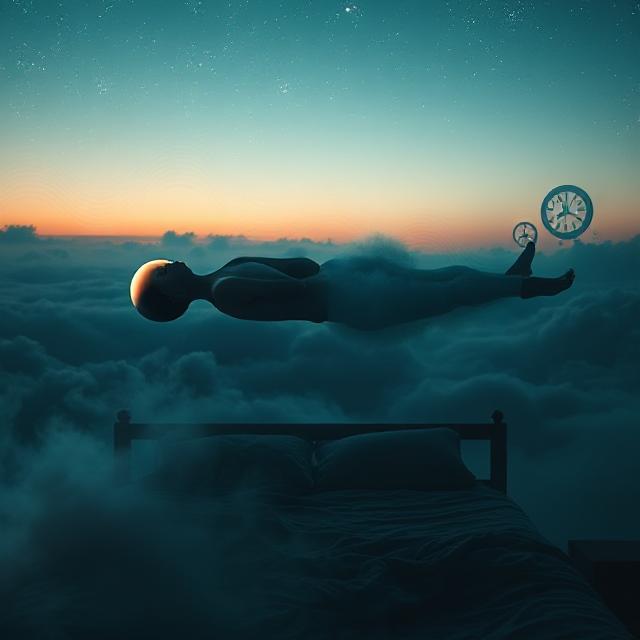
Table of Contents
Hypnagogia: The In-Between Brainwave State
Thereās a fleeting moment every night when your body relaxes, thoughts drift, and you begin to slide out of conscious control. Itās not full sleep, but itās no longer full wakefulness either. This transition state is called hypnagogiaāa strange, creative, and neurologically rich in-between realm.
In this article, we break down whatās happening in the brain during hypnagogia, what brainwave patterns dominate this state, and how artists, inventors, and thinkers have harnessed it for profound breakthroughs.
š What Is Hypnagogia?
Hypnagogia is the altered state of consciousness that occurs as you fall asleep, typically during Stage N1 sleep. Itās characterized by fleeting visuals, auditory distortions, surreal thoughts, and reduced control of attention.
You may have experienced:
- Feeling like you’re falling
- Hearing your name called, but no one’s there
- Seeing shapes or faces behind closed eyes
- Experiencing time distortion
- Having spontaneous ideas or realizations
Hypnagogia is not dreaming. Itās pre-dreamingālooser, stranger, but still partially aware.
š§ The Brainwaves of Hypnagogia
During hypnagogia, the brain shifts from alpha waves (8ā13 Hz) to theta waves (4ā8 Hz). Itās a descent from focused relaxation into early sleep.
| Brain State | Dominant Waves | Frequency |
|---|---|---|
| Wakeful Relaxation | Alpha | 8ā13 Hz |
| Hypnagogia | Alpha ā Theta | 13 ā 4 Hz |
| Light Sleep (N2) | Theta + Spindles | 4ā8 Hz + bursts |
This blend of alpha-theta crossover creates an unstable neural rhythmāideal for novel associations, image flashes, and lateral thinking.
š Cognitive Features of Hypnagogia
- Decreased sensory filtering: Your brain stops blocking out background noise or internal distractions.
- Heightened suggestibility: Ideas feel vivid, but not critically analyzed.
- Free association: Thoughts drift and blend, unconstrained by logical structure.
- Microdreams: Short bursts of dream-like sequences that may last 1ā10 seconds.
- Ego dissociation: Sense of āIā can fade or fragment.
These effects make hypnagogia both mysterious and incredibly useful.
šØ Hypnagogia and Creativity
Many iconic figures have tapped into hypnagogia for inspiration:
- Thomas Edison used steel balls in his hands to wake himself when they dropped, capturing ideas just as he fell asleep.
- Salvador DalĆ sketched dreamlike images the moment he entered the hypnagogic state.
- Beethoven, Tesla, and Richard Feynman all reported vivid mental imagery or insights during early sleep onset.
āHypnagogia is a portal to unconscious problem solving.ā
ā Neuroscience researcher Andreas Mavromatis
In hypnagogia, your brain is free to recombine concepts across domains, making it ideal for insight generation, artistic ideation, or resolving mental blocks.
š§Ŗ Scientific Interest in Hypnagogia
Recent neuroscience has shown that:
- Default Mode Network activity increasesālinked to self-reflection and imagination.
- Cortical inhibition decreases, allowing wider activation across brain regions.
- Frontal lobe activity lowers, reducing critical filtering.
These shifts mean more access to memory, emotion, and cross-modal associations.
MRI and EEG scans show that the transition into hypnagogia is one of the richest neural states, despite being brief and often forgotten.
š ļø How to Intentionally Enter Hypnagogia
You can train yourself to linger in hypnagogia with specific protocols:
1. Lie Down When Sleepy but Not Exhausted
- Best after a nap or in early afternoon.
- Avoid full sleep pressure.
2. Hold an Object
- Try Edisonās steel ball trick: hold something in your hand so youāll drop it as you driftāthis wakes you gently while keeping the last mental image intact.
3. Listen to Ambient Sound or Binaural Beats
- Alpha-theta tracks or low-frequency ambient music can help slow your brainwaves.
4. Keep a Journal Nearby
- Write immediately upon waking from a hypnagogic trance. Even fragments can be gold.
5. Use Hypnagogia for Idea Generation
- Focus on a question or problem before lying down. Your brain may āserveā you a solution without direct effort.
š§ Dangers and Limitations
While hypnagogia is largely benign, it can be confused with:
- Sleep paralysis (if paired with REM intrusion)
- Hallucinations in sleep disorders or narcolepsy
- False awakenings or lucid dream crossovers
Itās also important not to overuse the state as a replacement for deep sleep. Hypnagogia should complement, not substitute, healthy rest.
š§ Final Thought: The Brainās Creative Threshold
Hypnagogia is a threshold stateānot quite conscious, not fully asleep. Itās a zone of fluid thought, non-linear insight, and raw imagination.
By learning to recognize and explore this space, you open a rare gateway:
- To integrate knowledge
- To surface buried insights
- To access a wellspring of subconscious creativity
Donāt fear the drift.
That soft blur between wake and sleep might just be your sharpest mind.
